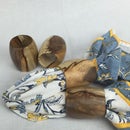Introduction: Bowl With Colored Pencil Inlay
I really enjoy working with colorful wood but that isn't always possible. You can use ink or dyes but I wanted to try something different. I have seen people turn entire bowls out of glued together colored pencils but never just using them as an artistic accent, at least not in this way. I have also put together a great video walking through this process so if you have any questions I hope that between the step by step approach and the video everything will be explained.
Step 1: Bowl #1 Fail-ish
To start this project I selected a plain light colored bowl that had been drying for over a month. While drying the bowl had warped almost 5/8" out of round so I had to start by putting it on the lathe to get it round again. I quickly discovered that once the bowl was brought back to round the wall thickness would be too thin to work with for this project. I had already started so I went ahead and finished it. As you can see above it ended up being thin enough to see light through!
Step 2: Applying an Exterior Grid to Bowl #2
The second bowl I selected had a much thicker wall, a lot less warp and the bonus of red streaks near the rim. Once this bowl was brought to round I started adding the grid that I would use to layout the holes. Starting towards the middle of the bowl I marked out multiple circles, each 1" bigger than the previous. Using the indexing function of my lathe and the tool rest as my straight edge I marked 24 radial lines evenly spaced around the exterior. I removed the bowl from my 4 jaw chuck and transferred to a set of jaws that can grab the outer edge. I decided I wanted the pattern to originate from the middle of the bowl so I need to have circle on the bottom as well.
Step 3: Determining the Pattern and Drilling the Holes
This is really where the creative part comes in! I decided to go with two swirling arms 180 degrees from each other. This design was really easy to layout. Starting at the middle I put an X 1 line out and 1 line over starting at the smallest circle. I could have easily added additional swirling arms as well using this method.
I hand drilled the holes because I wanted to have the pencils inserted a 90 degrees to the bowl wall. The colored pencils I used were round and 9/32" in diameter so naturally I used a 9/32 drill bit to insure a tight fit.
Step 4: Pencil Cutting Time
My depth gauge was able to fit in the drilled holes so I determined the average pencil thickness I would need throughout the bowl. The holes on the sides were at least 5/8" deep while the holes through the bottom were 1" deep. Using these two lengths I marked a piece of tape on my band saw to quickly be able to cut my pencils correctly. Once I had all of the colored pencils cut to length and separated into the two groups I decided I should bevel the exterior side of the holes to make it easier to insert (I think it helped). I latter learned that I only need a very small bevel. Several holes had a large bevel and during final turning I had to remove extra material to remove them.
Step 5: Getting Sticky Fingers
I applied a thin coat of wood glue to the shaft of each pencil segment and placed it over a hole. Almost all pieces needed to be hammered in place, which is a good thing. After about the 3rd segment your fingers are all going to be covered with glue so be careful how you grab the hammer or anything else.
My goal is to touch the exterior of the bowl as little as possible during final shaping (i.e. biggest OD I can get). For this reason I inserted the pencil from the outside. A few of the pencils stuck through the bowl's inner surface but most lay just below. I let the project dry for 2 hours before doing the final turning.
Step 6: Final Turning, Sanding and Finish
The only way I could really tell I was cutting through colored pencils was the occasional colored shavings that would build up on my bowl gouge. The pencils didn't provide any issues during turning or final sanding. I use butcher block oil, also known as mineral oil, to initially coat most of my bowls. From the picture above you can see that the bottom left of the bowl has been coated while the other half still has an untouched surface.
Step 7: Final Thoughts and Finished Photos
Using colored pencils is a fun and easy way bring interest to an otherwise boring piece of wood. Using structured patterns or random night sky approach the level of creativity is unlimited. I think it would be fun to add a monogram to the bottom of the bowl using colored pencils, maybe a great teacher's gift!
The great thing about these projects is that in the end you have a great bowl to share and the added confidence of successfully trying something new. Thank you for checking out my work, for more you can look me up at the following locations:
Etsy - https://www.etsy.com/shop/StoneCreekTurnings
Facebook - https://www.facebook.com/StoneCreekTurnings
YouTube - Search for StoneCreekTurnings




